One of the hottest trends in the health and fitness world, cold water immersion, or cold water therapy, is a therapeutic technique that involves immersing the body in cold water.
A cold plunge provides numerous health benefits, not to mention that when it's done right, it just feels great. So to get the most out of your therapy, it leads to the question: When is the best time to take a cold plunge?
In this article, we will explore how cold exposure helps heal the body and find out the best time of day to cold plunge.
Table of Contents:
- What Is A Cold Plunge?
- When Is The Best Time To Take A Cold Plunge?
- How Long Should You Cold Plunge For?
- How To Get The Ideal Cold Plunge Temp
- What's The Best Ice Bath?
- Benefits of Ice Baths
- Side Effects And Risks
- FAQs
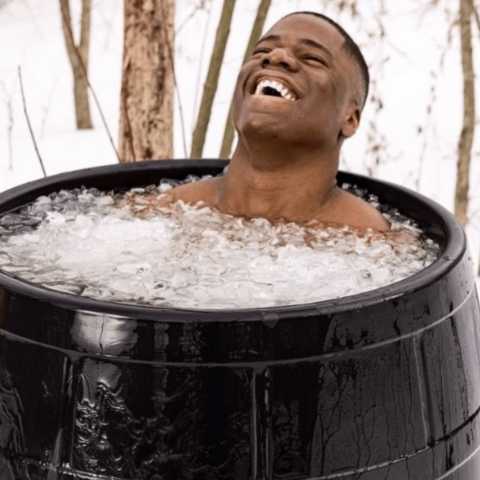
What Is A Cold Plunge?
A cold plunge is a type of cold water immersion therapy that involves dunking your entire body in cold water for short periods.
Cold water exposure has been proven to have a wide range of health benefits, including weight loss, muscle recovery, reduced stress, improved immune system, and more. To take the plunge, you can use a bathtub, pool, tank, or natural body of water.
Researchers agree that for cold water immersion therapy to be effective, the water temperature must be between 50 and 59℉ (10 to 15℃). Once you are sure of the temperature, take a dip for around five to fifteen minutes.
Beginners should try starting on the shorter end, going only waist-deep until they get comfortable. From there, plungers can gradually increase the depth (up to neck level) and time with experience. If you're new to cold therapy, beginning with cold showers is another good strategy.
When Is The Best Time To Take A Cold Plunge?
The best time to do a cold plunge depends on your goal and desired benefit.
For those suffering from depression, need a boost in mental clarity, or are looking for a way to help wake you up and energize for the day, aim for the morning. Cold temperatures trigger our brains in a way that can improve alertness, energy, and clarity. This can be a natural alternative to chugging coffee or another wake-me-up beverage.
If you are an athlete, weight lifter, or exercise consistently, a post-workout cold plunge is ideal. An ice bath post-workout can help accelerate recovery by reducing inflammation and soreness, especially when combined with a hot tub soak. This is why professional athletes often soak in ice bath tubs or a contrast bath after training, which you can learn more about in our article: Why Do Athletes Take Ice Baths?
There is one exception, though. If your goal is acute muscle hypertrophy, skip the post-workout ice bath. Evidence shows that cold plunges immediately after training can blunt the muscular damage required for anabolic growth1.
Lastly, some believe the best time for a cold plunge is before sleep. Cold exposure causes the body's temperature to drop, which can help people to relax and promote a better quality of sleep. Anecdotal evidence supports this concept, with several users supporting a pre-bedtime cold plunge.
However, real-life testimony shows success stories for all three periods.
One Reddit user stated: "I love doing ice baths in the evening. I sleep amazing."
(source) Another user said: "Morning is great, really kicks some awareness into you. I just feel so alive and in the moment." (source)
And, a separate Redditor added: "In the morning, since it gives you a dopamine boost for a few hours." (source)
There is no correct answer for the best time to cold plunge. It all comes down to personal preferences and goals. Regardless of what time you choose, there will be plenty of health benefits.
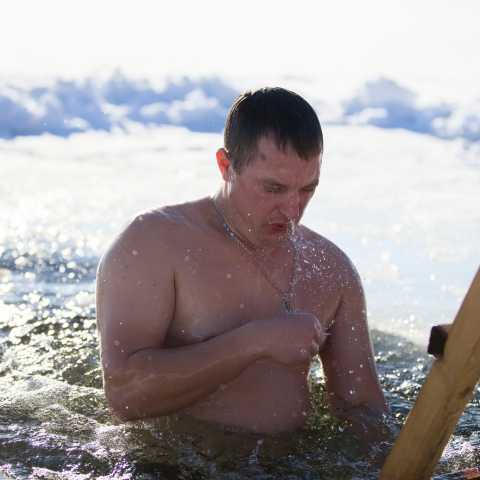
How Long Should You Cold Plunge For?
If you have never tried a cold plunge before or are a beginner, starting slow is essential.
Beginners should start with short periods, between 30 seconds and three minutes, to help build stamina and experience. Listen to your body; if you feel comfortable, add 15-30 seconds each time until you reach a time that feels perfect for you.
Most experts agree that the five-minute range is ideal to reduce muscle soreness, improve circulation, and get other benefits. If you're experienced and want to go longer, however, make sure to limit cold plunges to twenty minutes or less to avoid negative consequences.
That's because when our bodies experience colder temperatures, it causes our core body temperature to drop, which can lead to confusion and potentially hypothermia. We recommend you use a stopwatch or alarm clock to ensure you don't accidentally stay in too long and put yourself at risk.
For a more in-depth breakdown of this question, check out our article: How Long Should You Stay In An Ice Bath?
How To Get The Ideal Cold Plunge Temp
As mentioned above, an ice bath temperature must be between 50 and 59℉ (10 to 15℃). Getting the ideal temperature ensures you get the desired benefits and avoid hypothermia.
One of the best methods for preparing an ice bath or cold plunge is to fill a tub or container with cold water and ice. You can easily add more ice until you reach the desired temperature. Another common method is a natural cold water immersion, which can be done in any body of water, such as a river or lake. However, as you can't control the temperature, it could be dangerously cold. Plus, not everyone lives in areas with access to water.
The best way to get the ideal ice bath temperature is to use an automated ice bath or machine. Technological advances have made precise temperature control easy, and there are several quality products available. These machines can consistently provide the perfect water temperature with ease, making your cold plunge efficient and easy to control.
For even more cold plunge tips on how to get the best ice bath temperature, check out our article: How Cold Should An Ice Bath Be?
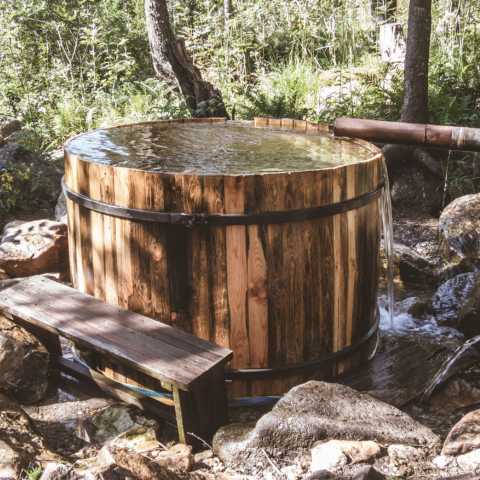
What's The Best Ice Bath Tub?
I just mentioned that an automated ice bath is key for getting the ideal temperature and it's definitely easier than adding buckets of ice to your tub.
If you're looking for a recommendation, the best cold plunge tub available today is PLUNGE, by the creators of Cold Water Plunge on TV's Shark Tank. Their revolutionary technology combines powerful cooling, filtration, and sanitation to provide clean, ice cold water.
While many products on the market require you to make or add the ice yourself, this plunge is ready to use instantly. The tub is 67 inches long, 28 inches deep, and 43 inches wide, so it should comfortably fit most people. They also offer a PLUNGE XL version with larger dimensions. Empty, the tub weighs 150 pounds, but when full, it is 1,000 pounds.

Our revolutionary Cold Plunge uses powerful cooling, filtration, and sanitation to give you cold, clean water whenever you want it, making it far superior to an ice bath or chest freezer...
With a guaranteed one-year warranty and the option to lengthen the warranty by multiple years, you can feel secure with your investment. To learn more about this product and others, check out our article on the 5 Best Ice Bath Tubs.
6 Benefits Of Ice Baths
Ice baths and cold therapy have several health benefits when used properly. Below are some of the top ice bath benefits.
1) Fat Loss:
Studies have shown that cold exposure causes an increase in metabolic rate and activates brown fat. Brown adipose tissue (brown fat), known as the good fat, burns calories to produce heat. Cold exposure also leads to more calories burned because the body has to work harder to raise the core temperature.
Another study using mice showed increased metabolic rate, activation of brown fat, and improved glucose homeostasis with cold plunges2. This significantly increased energy expenditure, so the scientists responded by increasing food intake to compensate for the energy requirement. However, if food intake is kept constant, the extra energy burned could lead to fat loss.
2) Boost Immune System:
One of the primary reasons people have ice bath sessions is to help boost their immune system. Studies have shown that cold exposure, including cold water therapy, helps increase the production of white blood cells.
White blood cells help protect the body from disease and illness, so increasing them will help strengthen the immune system3.
3) Improve Circulation:
Cold plunging triggers our blood vessels to constrict, which sets off a chain of reactions. Once you exit the plunge, your body tries to warm itself by causing the blood vessels to expand.
This two-step process helps direct blood toward the organs and transports oxygen and nutrients. The increase in blood flow leads to several other benefits, such as improved recovery and skin health.
4) Improve Hair And Skin:
Cold water therapy has been shown to help support hair and skin health. Cold exposure causes our pores to close, which can help prevent bacteria from entering. Improved circulation also helps the skin because it helps tighten the pores and give the skin a healthy glow.
Hot water has also been shown to damage keratin cells, affecting the skin and hair.
5) Reduce Muscle Soreness:
Perhaps the most common reason people use ice baths is to help muscle recovery and reduce muscle soreness after exercise.
The constriction of blood vessels restricts blood flow, which temporarily can reduce inflammation. However, once you get out of the ice bath, your blood vessels dilate as they warm back up, opening up the channels for increased blood flow. This rush of new blood helps carry oxygen and nutrients to the muscle cells, further helping recovery and reducing soreness. This pattern of decreased and increased blood flow helps shuttle toxins and waste away from nutrients toward sore, tired areas.
Lastly, cold water therapy also helps reduce inflammation, another critical factor for muscle soreness and promoting recovery. An analysis of 20 studies concluded that cold water immersion led to significantly better recovery from exercise-induced muscle damage, including delayed-onset muscle soreness (DOMS)4.
6) Improved Alertness/Mental Clarity:
As mentioned above, some people believe the best time for an ice bath is the morning because of the boost in energy and mental clarity.
Cold exposure causes a "shock" to the body, triggering our fight-or-flight reaction. This shock increases blood flow to the brain and triggers the release of endorphins that help improve alertness, energy, and clarity.
It also triggers the release of several hormones, including adrenaline and noradrenaline, which further helps improve mental clarity. Some studies have suggested that the boost in endorphins caused by cold water therapy can help relieve depression symptoms5.
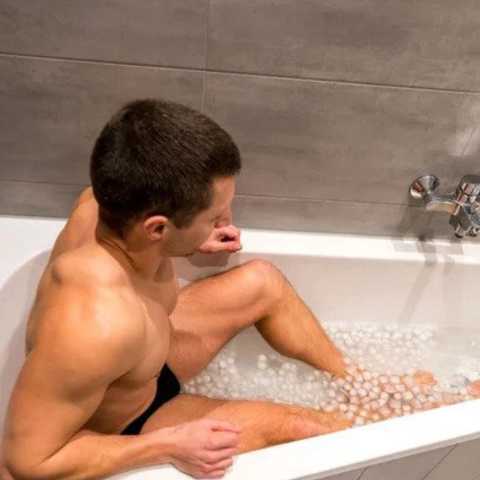
Side Effects And Risks
While cold water therapy has numerous health benefits, there are potential side effects and risks. We recommend you speak with a healthcare professional before starting cold water therapy.
- Hypothermia: The most obvious of the side effects, cold exposure can cause hypothermia, especially if you are in water that is too cold or stay in too long. Hypothermia can cause confusion, fatigue, loss of consciousness, and death.
- Cold Shock Response: The cold shock response is a series of bodily reactions from extreme cold exposure. The "shock" when you first enter the water can cause you to gasp your breath, rapidly increase your breathing, and elevate your heart rate. This gasp is the most common cause of death from extreme temperatures. It also leads to other side effects, including increasing blood pressure and placing stress on the heart.
- Cardiovascular Stress: In connection to the cold shock response, the elevated blood pressure and increased heart rate strain the heart. This is especially significant to cardiovascular patients because it increases the risk of stroke, heart disease, and other deadly illnesses.
- Frostbite: Frostbite is another condition, like hypothermia, that is contracted from freezing temperatures. Frostbite causes the skin and tissues to freeze, which can cause numbness, tingling, and discoloration.
- Muscle Stiffness/Risk of Injury: After you exit an ice bath, your muscles will be stiff, and your joints will have decreased mobility. This combination can lead to injury if you overexert yourself too soon.
- Not Safe For Everyone: It's essential to speak with a medical professional before a cold plunge because it can be dangerous if you have certain conditions or diseases. Some people who should avoid cold water therapy include those with Raynaud's disease, cold urticaria, arthritis, and people with heart, blood pressure, or circulatory issues.
FAQs
These are some of the most commonly asked questions related to cold plunge.
Is it better to take a cold plunge in the morning or at night?
Both can be beneficial. The morning is better for people who desire a boost in energy or mental clarity. The night is better for people who want a better quality of sleep.
Is it OK to cold plunge every day?
For the most experienced cold plungers, it is okay to do it daily. However, most people would benefit from 2-3 times a week maximum, as the body needs time to recover.
Can you overdo cold plunge?
Yes, you can overdo a cold plunge and put yourself at risk for hypothermia or worse. You should spend a maximum of 20 minutes and do not use water below 50℉ (10℃).
Does cold plunge boost testosterone?
Some researchers suggest that, yes, a cold plunge could boost testosterone. However, the science is inconclusive, and many suggest any boost in testosterone is very small and short-lived. We talk about cold therapy and testosterone more in-depth in our article: Do Cold Showers Boost Testosterone?
Should you stretch after cold plunge?
Yes, you should stretch after a cold plunge, but wait until your body warms up naturally, and do not overdo it. Stretching when cold can cause injury, so be sure to perform light, gentle stretches.
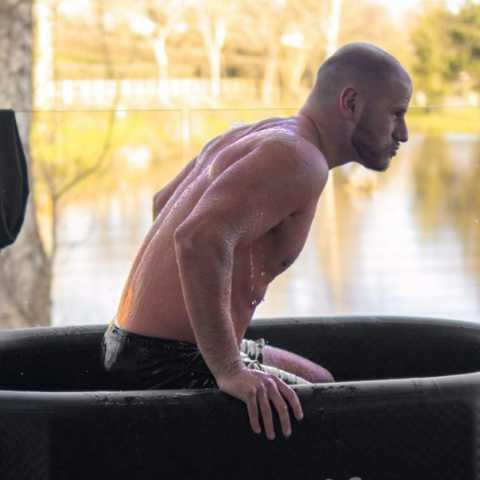
When To Take An Ice Bath: The Final Say
The best time to cold plunge ultimately depends on your goals.
When immersed in cold water, our bodies trigger the fight-or-flight response, increasing blood flow and endorphins. Cold water exposure also restricts blood flow, lowers the inflammatory stress response, and activates brown fat.
Therefore, if you want an increase in energy and a boost in mental clarity to start the day, the morning would be best. If you need help to improve your sleep quality, at night would be best. A post-workout cold plunge would be best for athletes and gym-goers looking for recovery and reduced soreness.
Finally, if you plan to make cold plunges a part of your regular routine, consider purchasing a cold tub. Cold tubs are the best way to control the temperature for consistent, convenient plunges. Regardless of what time you choose, your overall health and quality of life will improve with cold water therapy.
Now that you know when to take a cold plunge, check out the 5 Best Ice Bath Tubs to ensure you can take one at your ideal time!

The Rubbermaid Commercial Stock Tank, 150 gallon, has a sleek appearance and smooth black color. This 150 gallon stock tank features an easy-to-use drain and seamless structural foam construction that resists weathering and cracking for long use...
References:
- Roberts LA, Raastad T, Markworth JF, Figueiredo VC, Egner IM, Shield A, Cameron-Smith D, Coombes JS, Peake JM. Post-exercise cold water immersion attenuates acute anabolic signalling and long-term adaptations in muscle to strength training. J Physiol. 2015 Sep 15. doi: 10.1113/JP270570. Epub 2015 Aug 13. PMID: 26174323; PMCID: PMC4594298.
- Ravussin, Yann, et al. “Effect of Intermittent Cold Exposure on Brown Fat Activation, Obesity, and Energy Homeostasis in Mice.” PLoS ONE, vol. 9, no. 1, 17 Jan. 2014, www.ncbi.nlm.nih.gov/pmc/articles/PMC3895006.
- Brenner, I. K. M., et al. "Immune Changes in Humans during Cold Exposure: Effects of Prior Heating and Exercise." Journal of Applied Physiology, vol. 87, no. 2, 1 Aug. 1999. https://ift.tt/t3XrVKu.
- Xiao, Feiyan, et al. "Effects of Cold Water Immersion after Exercise on Fatigue Recovery and Exercise Performance--Meta Analysis." Frontiers in Physiology, vol. 14, 20 Jan. 2023, p. 1006512, https://ift.tt/0P2tf4n, https://ift.tt/MkpI6Rl. Accessed 28 Feb. 2023.
- Shevchuk, Nikolai A. "Adapted Cold Shower as a Potential Treatment for Depression." Medical Hypotheses, vol. 70, no. 5, Jan. 2008. https://ift.tt/k3pyBsW, https://ift.tt/e4xgKCd.

0 Comments